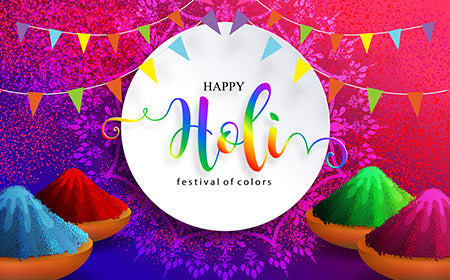
Holi Festival
25th March 2024, Holi is an essential spring celebration for Hindus, a national occasion in India, a provincial occasion in Nepal and different nations. To numerous Hindus and some non-Hindus, it is a perky social occasion and a reason to toss shaded water at companions or outsiders jokingly.
Holi is a Hindu spring celebration celebrated in the Indian subcontinent, otherwise called the "celebration of hues" or the "celebration of affection". The celebration means the triumph of well-finished underhandedness, the entry of spring, the end of winter, and for some, a bubbly day to meet others, play and snicker, overlook and pardon, and repair broken connections. It is additionally celebrated as a thanksgiving for a decent reap. It goes on for a night and a day, beginning on the night of the Purnima (Full Moon day) falling in the month of Phalguna, which falls somewhere close to the finish of February and the center of March in the Gregorian date-book. The primary night is known as Holika Dahan or Chhoti Holi and the next day is Holi, Rangwali Holi, Dhuleti, Dhulandi, or Phagwah.
Holi is an essential spring celebration for Hindus, a national occasion in India, a provincial occasion in Nepal and different nations. To numerous Hindus and some non-Hindus, it is a perky social occasion and a reason to toss shaded water at companions or outsiders jokingly. It is along these lines watched extensively in the Indian subcontinent.
The celebration has numerous reasons, most noticeably, it commends the start of Spring. In seventeenth-century writing, it was recognized as a celebration that praised agribusiness, remembered great spring harvests and the prolific land. Hindus trust it is a period of making the most of spring's bounteous hues and saying goodbye to winter. To numerous Hindus, Holi celebrations stamp the start of the new year and also an event to reset and recharge burst connections, end clashes, and free themselves of gathered passionate polluting influences from the past.
History and ceremonies
Holi is an old Hindu celebration with its social ceremonies. It is specified in the Puranas, Dasakumara Charita, and by the writer Kalidasa amid the fourth-century rule of Chandragupta II. The festival of Holi is likewise said in the seventh century Sanskrit show Ratnavali. The celebration of Holi got the interest of European dealers and British pilgrim staff by the seventeenth century. Different old releases of Oxford English Dictionary specify it, yet with shifting, phonetically inferred spellings: Houly (1687), Hooly (1698), Huli (1789), Hohlee (1809), Hoolee (1825), and Holi in versions distributed after 1910.
Traditional sources of colors
Orange and red
The blossoms of palash or tesu tree additionally called the fire of the backwoods are the commonplace wellspring of brilliant red and profound orange hues. Powdered fragrant red shoe wood, dried hibiscus blooms, madder tree, radish, and pomegranate are substitute sources and shades of red. Blending lime with turmeric powder makes a substitute wellspring of an orange powder, as does bubbling saffron (Kesar) in water.
Green
Mehendi and dried leaves of the Gulmohar tree offer a wellspring of green shading. In a few zones, the leaves of spring yields and herbs have been utilized as a wellspring of green color.
Yellow
Haldi (turmeric) powder is the run-of-the-mill wellspring of yellow shading. Once in a while, this is blended with chickpeas, gram, or other flour to get the correct shade. Bael organic product, amaltas, types of chrysanthemums, and types of marigold are exchange wellsprings of yellow.
Blue
Indigo plants, Indian berries, types of grapes, blue hibiscus, and jacaranda blooms are conventional wellsprings of blue shading for Holi.
Magenta and purple
Beetroot is the customary wellspring of maroon and purple shading. Frequently these are straightforwardly bubbled in water to get ready shaded water.
Brown
Dried tea leaves offer a wellspring of dark-colored shaded water. Certain muds are substitute wellspring of dark-colored.
Black
Types of grapes, products of amla (gooseberry), and vegetable carbon (charcoal) offer dim to dark hues.
Holi powder
Synthetic colors
Common hues were utilized as a part of the past to observe Holi securely by applying turmeric, sandalwood glue concentrates of blossoms, and takes off. As the spring-blooming trees that once provided the hues used to observe Holi have turned out to be more uncommon, synthetically delivered mechanical colors have been utilized to have their spot in all of urban India. Because of the business accessibility of alluring shades, gradually the common hues are supplanted by manufactured hues. Thus, it has made gentle extreme side effects of skin disturbance and irritation. The absence of control over the quality and substance of these hues is an issue, as they are as often as possible sold by merchants who don't have the foggiest idea about their source.
Ecological effect
A charged natural issue identified with the festival of Holi is the conventional Holika blaze, which is accepted to add to deforestation. Activists gauge Holika causes 30,000 blazes each year, with everyone consuming around 100 kilograms of wood. This speaks to under 0.0001% of 350 million tons of wood India devours each year, as one of the conventional energizes for cooking and different employments.
The utilization of overwhelming metal-based colors amid Holi is likewise answered to cause impermanent wastewater contamination, with the water frameworks recuperating to pre-celebration levels within 5 days.
Holi-inspired events
Various Holi-motivated get-togethers have additionally surfaced, especially in Europe and the United States, frequently sorted out by organizations concerning benefit or philanthropy occasions with paid confirmation, and with shifting planning that does not match with the real Holi celebration.
